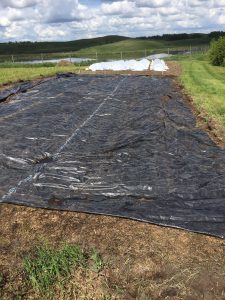The windy Alberta spring is well underway, and so are our plans for the summer gardening season. As we’ve charted out our veggie crops, though, we’ve come to the conclusion that we are (yet again!) in need of more garden space. While we do have a fair amount of land fenced off inside our garden enclosure, what isn't already being cultivated is covered in tall, well-established grasses. Mixed in among those wild grasses are a multitude of weeds, including dandelions, clover, and a variety of thistles. We definitely don’t want these competing with our vegetables for precious nutrients!
Our organic practices are very important to us, however. We do not want to drench the soil in herbicide. Instead we use a process called occultation.
Occultation kills the plants by covering them up. Thick covers deprive the plants of light, so they cannot photosynthesize and eventually starve. It’s sort of like what happens when you leave a planter or a large rock on your lawn for several weeks: when you lift up the bucket, the grass underneath is brown and dead. That’s the process we have undertaken for our gardens, but on a larger scale.
Here you can see our large, heavy tarps spread out and anchored over the new garden ground:
As the grass dies, it shrinks down in volume and the tarps become much flatter:
We chose a black tarp not only because it stops the light, but also because the black tarps help to warm the soil. Warm, wet soil means any weed seeds in the soil will germinate. But as they’re trapped beneath that tarp, without any light, they will all die off!
Once all the grass is dead and the weed seeds have germinated and died, we will till the dead organic matter back into the ground. And voila! We have a whole new field of rich earth to grow more vegetables.






